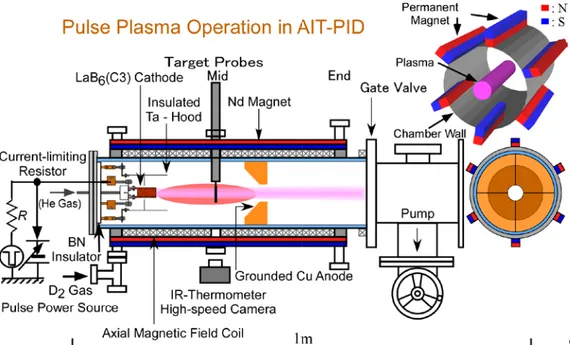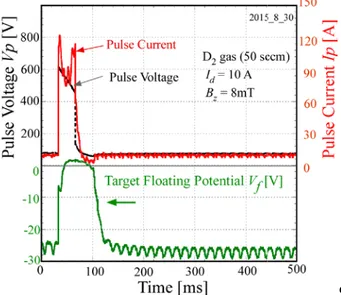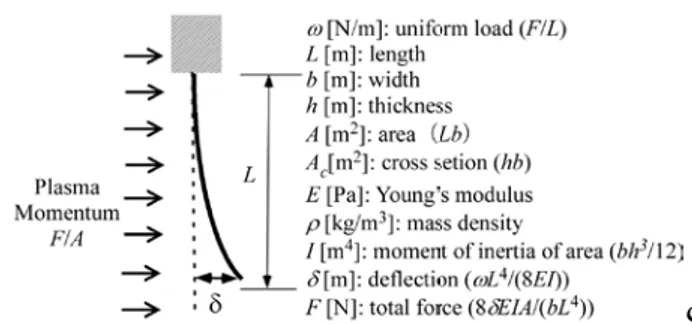Observation of Mechanical Oscillation induced by Pulsed Plasma-Momentum
Injection to Tungsten Foil in AIT-PID for Fusion Studies
核融合研究のため AIT-PID に設置されたタングステン箔へのパルスプラズマ運動量入射に伴う 機械的振動の観測
Shuichi TAKAMURA✝,Tatsuya KUWABARA✝ ✝,Yoshihiko UESUGI✝ ✝ ✝ 髙村 秀一✝
, 桑原 竜弥✝ ✝,上杉 喜彦✝ ✝ ✝
Abstract Mechanical oscillation of tungsten (W) foil induced by pulsed plasma-momentum injection was observed in addition to its deflection in linear plasma generation device AIT-PID for fusion studies. It is motivated by a worry about an enormous heat flow into divertors: Edge Localized Mode (ELM) in magnetically confined fusion devices. The importance of plasma-momentum must be noted here in addition to a large amount of heat flux, especially on liquid metal divertor and melted layer of W wall surface. Visualization of momentum injection was obtained by the observation of mechanical oscillation of W foil which was modeled numerically as a cantilever configuration. The comparison of oscillation frequencies between the observation and cantilever model was made in addition to the oscillation amplitude.
1. Introduction
Plasma-momentum input to plasma-facing material surfaces has not been recognized well as one of important plasma-surface interaction (PSI) in fusion devices1, 2). However, its role associated by ELM- induced pulsed plasma heat flow onto divertor target surface in magnetically confined fusion devices has been recently noted because the melting of target surface3~5), mainly made of W, made a fluid-mechanical motion such as Kelvin-Helmholtz instability at melted W surface layer6). A liquid metal divertor has been also discussed for a mitigation of the above-mentioned extremely high heat flux7). In this configuration, plasma-momentum injection onto the liquid surface may also induce a variety of fluid-mechanical instability.
† Aichi Institute of Technology, Toyota 470-0392 †† Nagoya University, Nagoya 464-8603
††† Kanazawa University, Kanazawa 920-1192
On the other hand, plasma-momentum related to propulsion of thrusters has been investigated8, 9). And, the reactive plasma - liquid metal interaction has been studied for its industrial applications10, 11).
Here, pulsed plasma-momentum flux to W material surface is discussed in terms of mechanical oscillation of W foil observed in a linear plasma device for fundamental studies1, 2) on fusion plasmas.
2. Plasma Momentum Input to Material Surface
Plasma momentum input to facing-material surface is composed of several origins. First of all, plasma ions accelerated through a plasma sheath just in front of the surface including a pre-sheath give impact on the target surface in addition to thermal ion momentum. Some part of ions incident to the target surface are reflected on the surface so that the momentum reflection coefficient should be defined1) to estimate particle reflection caused reaction. Similarly, the physical sputtering on the surface also contributes to the
momentum input1). When the surface temperature of target material increases substantially, arriving at melting of solid materials or in the case of intrinsically liquid surface, evaporated atoms, molecules and clusters may produce another momentum input due to reaction of rocket effect1).
Electron inertia is so small that the plasma electron contribution to plasma momentum input to the material surface could be neglected usually since the electron particle flux to the target surface is equal to that of ions under the electrically floating condition of the cold surfaces. However, it could not be the case if the thermo-electron emission becomes exponentially large for an enormous increase in surface temperature, associated by an almost equivalent increase in thermal electrons influx because the floating potential of the surface approaches the plasma potential.
In the melted surface due to, for example, a large ELM heat flow, a plasma fluctuation or turbulence with spatial variation just in front of the surface would give some inhomogeneities of momentum influx to the liquid metal surface which could be coupled with
fluid-mechanical motion such as Kelvin-Helmholtz instability6) of melted tungsten layer12).
3. Experimental Observation and Analyses
3.1 Plasma Irradiation Device
Figure 1 shows a linear plasma generation device, AIT-PID (Aichi Institute of Technology – Plasma Irradiation Device)13, 14) for a pulsed plasma beam injection. Plasma beam comes from the left-hand (plasma source) side. W target was inserted at the Mid position. A steady state discharge current is 10 A with the deuterium gas feed of 50 sccm and axial magnetic field intensity of 8 mT. The plasma is confined radially with a multi-cusp magnetic field generated with six permanent magnet bars. A pulse negative voltage with the pulse length of 33.3 ms was applied to the cathode with respect to the grounded copper anode through a current-limiting resistor R of 2.2 Ω. The plasma electron temperature was about 5 eV which does not change even within the pulse period. The plasma density increases by a factor of five, reaching
Fig.1 Linear plasma generator AIT-PID for pulsed operation. Current limiting resistor R is connected in series to negative pulse power supply with respect to the grounded Cu anode. R = 2.2 Ω. The wall of vacuum chamber is also grounded electrically. The working gas D2 is supplied laterally via a gas flow controller. The tungsten target
approximately 1×1019 m-3.
Figure 2 shows a W target, where (a) is the photo of the target with dimension of 25 mm×25 mm, and thickness of 15 µm. The target was supported with a pair of thick W wire which were put through ceramic tube. Fig.2(b) shows a model configuration of the target as a cantilever for a simplification of numerical model.
Figure 3 shows the time evolutions of pulsed discharge parameters: pulse voltage and current, and
the floating potential Vf of the W target foil. The plasma potential is about positively 5 V, and does not change largely during the pulsed discharge. During the pulse, Vf approaches the plasma potential due to a strong electron emission from the target because the target temperature becomes around the melting point over 3500 K due to the pulsed plasma heat flux so that the W has a strong thermo-electron emission capability. At the same time, the W evaporation becomes substantial.
Fig.2 Employed tungsten target foil. (a) the photo after several pulsed plasma heat irradiation. (b) The corresponding cantilever configuration.
Fig.3 Time history of pulse current and voltage at the discharge cathode. Target floating potential Vf was measured with respect to the grounded vacuum chamber, Small oscillation in Vf trace comes from AC 60 Hz current through the LaB6 cathode coil.
Fig.4 Time history of the lowest edge of target tungsten foil. Pulse length of plasma heat flux is 33.3 ms. The vertical axis, here, has an arbitrary scale. Roughly speaking, the value of deflection is close to that in mm.
3.2 Experimental Observation of W Foil Oscillation and Comparison with Cantilever Model
The temporal change in the horizontal displacement of lowest side of the target is plotted as a function of time in Fig.4 where the inset is the photo of the target just before the pulsed plasma heat flow, which was taken through a vacuum viewing port with the interference optical filter of WI (498.26 nm). The vertical axis is arbitrary, but roughly in mm.
The quasi-stationary displacement during the heat pulse is about 10 ~ 20 mm, depending on pulse voltage and current, so that the cantilever model shown in Fig.5 gives the pressure force of 30 ~ 70 Pa, which was discussed in detail by us1). This deflection corresponds to the initial amplitude of mechanical oscillation.
The cantilever model gives us the frequency of fundamental mode as follows:
where the meanings of variables are shown in Fig.5, and λ = 1.875 is the eigen value for the fundamental oscillation mode. Equation (1) gives f = 21 Hz in the present case. It means that the period would be 48 ms, while the experimental observation gives 40~45 ms. Therefore, we can say a fairly good agreement between experimental observation and the simple modelling. Numerical values for this modelling are summarized in Table I. We should note that Young’s modulus E of W target depends on its thermal history because a recrystallization makes W harder than its pristine one.
We note that the theoretical value of oscillation frequency is proportional to square-root of E. There must be a difference in frequency between pristine W and recrystallized one.
4. Summary
Pulsed plasma momentum input to W foil is realized by a pulsed plasma heat flux generation, which was originally considered to simulate ELM-like heat pulse to W surface for the purpose of study on effects of emitted W vapor, cluster and atoms on its surrounding divertor plasma properties, e.g. cooling15).
Here, deformation or bending of W foil followed by a mechanical oscillation was analyzed in terms of deflection and oscillation frequency, using a cantilever model. Although the setting and support of the experimental W foil target are not modeled precisely by a cantilever, the obtained numerical values are fairly reasonable, as summarized in Table I. The observed attenuation of foil oscillation is also interesting. It would be affected by not only material properties but also surrounding plasmas.
Some discussions on the effect of plasma momentum input to liquid metal surfaces are given in relation to melted metal layer in magnetically confined fusion Fig.5 Parameters in cantilever oscillation model.
Table I Numerics for cantilever with uniform load. Dimension of target foil (L, h, b, A = Lb) are given by experimentally employed values. Material properties are employed for pristine tungsten. Deflection (1~2×10-2 mm) is the typical value in the experiment.
plasma, ion thrusters, and reactive plasma synthesis.
Acknowledgement
This work was supported by JSPF KAKENHI Grant Number 17K06996.
References
1) S. Takamura, Y. Uesugi, and T. Kuwabara,”Effect of PSI on Momentum Input to Plasma-Facing Material Surfaces”, Contrib. Plasma Phys. 56, 681 (2016).
2) S. Takamura and Y. Uesugi, “Coupled interaction between tungsten surfaces and transient high-heat-flux deuterium plasmas”, Nucl. Fusion 55, 033003(2015). 3) S. Brezinsek and JET-EFDA Contributors,
“Plasma-surface interaction in the Be/W environment: conclusions drawn from the JET-ILW for ITER”, J. Nucl. Mater. 463, 11 (2015).
4) B. Lipschultz, J.W. Coenen, H.S. Barnard, N.T. Howard, M.L. Reinke, D.G. Whyte and G.M. Wright, “Divertor tungsten tile meltings and its effect on core plasma performance”, Nucl. Fusion 52, 123002 (2012).
5) G.G. van Eden, T.W. Morgan, D.U.B. Aussems, M.A. van den Berg, K. Bystrov, and M.C.M. van de Sanden, “Self-Regulated Plasma Heat Flux Mitigation Due to Liquid Sn Vapor Shielding”, Phys. Rev. Lett. 116, 135002(2016).
6) G. Miloshevsky and A. Hassanein, “Splashing and boiling mechanisms of melt layer losses of PFCs during plasma instabilities”, J. Nucl. Mater. 438, S155 (2013). 7) M. Shimada and Y. Hirooka, “Actively convected liquid
metals divertor”, Nucl. Fusion 54, 122002 (2014).
8) S.A. Cohen, F. Zonca, J. Timberlake, T. Benett, J. Cuthberton, W. Layer and R. Motley, “An instrument for measuring the momenyum flux from atomic and charged particle jets”, Rev. Sci. Instrum. 61, 3586 (1990). 9) B.W. Longmier, B.M. Reid, A.D. Gallimore, F.R.
Chang-Diaz, J.P. Squire, T.W. Glover, G. Chavers, and E.A. Bering, “Validating A Plasma Momentum Flux Sensor Against An Inverted Pendulum Thrust Stand”, J. Propulsion Power 25, 746 (2009).
10) K. Sasaki and H. Koyama, “Magnetron sputtering of liquid tin: Comparison with solid tin”, Applied Phys. Express 11, 036201 (2018).
11) T. Trottenberg and H. Karsten, “Measurement of forces exerted by low-temperature plasmas on a plane surface”, Plasma Sources Sci. Technol. 26, 055011 (2017). 12) J.W. Coenen, G. Arnouk, B. Bazylov, G.F. Mattews, S.
Jachmich, et al., “ELM induced tungsten melting and its impact on tokamak operation”, J. Nucl. Mater. 463, 78 (2015).
13) S. Takamura, N. Naito, M. Nishikawa, T. Miyamoto, “Characteristics of Compact Plasma Device AIT-PID with Multicusp Magnetic Confinement”, Bulletin of Aichi Institute of Technology, 47, 175 (2012), URI: http://hdl.handle.net/11133/1529
14) S. Takamura, “Characteristics of the Compact Plasma Device AIT-PID with Multicusp Magnetic Confinement”, IEEJ Trans. on E. E. Eng. 7(S1), S19 (2012).
15) Y. Kikuchi and S. Takamura,”2. Experimental Studies of a Plasma with Multi-Phase Matters on Fusion PWI Research Fields”, J. Plasma Fusion Res. 93, 354 (2017), http://www.jspf.or.jp/journal/PDF_JSPF/jspf2017_08/jsp f2017_08_354.pdf, in Japanese


